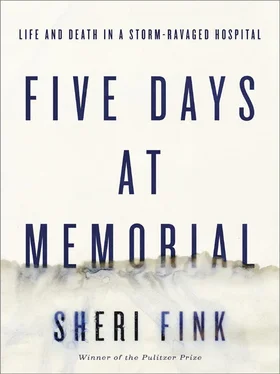For a moment, Gershanik considered the larger reality, the competing priorities that had emerged as waters suffocated an entire city. He was only doing what is ingrained in a doctor—advocating for his own patients—but now he saw that the struggle to save lives extended far beyond the two critically ill neonates in the helicopter, or Memorial’s entire population of sick babies, or even the whole hospital, much as it had seemed like the universe when he was back there. He used the delay to switch oxygen tanks with some difficulty. He apologized for his impatience.
Back on the helipad at Memorial, some of the remaining neonatal ICU nurses had taken to waving down passing helicopters like hitchhikers putting out a thumb. The activity on the helipad drew the attention of a mass of hospital onlookers, who had climbed upstairs to watch. They were hot and had only time on their hands. The air of chaos surprised a newly arrived coordinator for Acadian, who was moving from hospital to hospital with several small medical helicopters to evacuate critical patients. Other hospitals had been more organized. On the northeast edge of Memorial’s helipad, he put down a cooler filled with sandwiches for his hardworking flight crews. It was promptly ransacked and emptied by Memorial staff and strangers loitering on the tarmac.
The doctors on the helipad had gone from practicing medicine to, at least in one case, arguing with a Coast Guard pilot about how many patients could fit in his helicopter. The pilot flew away to rescue people elsewhere. A nurse who was also an Air Force captain witnessed the scene and was upset at losing a helicopter. She knew that these pilots ruled the air and, having logged thousands of search-and-rescue flight hours, could be trusted to know their capacity. She approached Dr. Richard Deichmann, the chairman of medical services managing the helipad, and told him the Air Force had trained her to run a flight line in an emergency. He put her in charge, and she cleared the helipad of doctors and patients, sending them to wait in the wind-protection tunnel. She shooed people off the hospital rooftops so that the pilots could keep landing.
Memorial staff members began loading the last group of critically ill babies onto a helicopter. Its pilot had a flight plan for a hospital west of Baton Rouge instead of the hospital that had agreed to accept Memorial’s neonates.
The neonatal ICU nurses resisted. They had no idea whether the other hospital was prepared to support the lives of their fragile charges. Richard Deichmann said the babies could leave. “The babies will be taken to wherever the pilot is going,” he told the nurses and, via walkie-talkie, their director in the hospital. “This is a disaster.”
“Then we will remove the babies from the helicopter,” the nursing director in charge of the neonates radioed back, contradicting him in spite of the unwritten hospital hierarchy that put doctors on top. She told Deichmann that the pilot had to find a way to fly to Baton Rouge or she would not allow him to take the neonates. Within minutes the pilot received approval for a flight plan to Baton Rouge.
A text message arrived a few hours later from Baton Rouge. All the babies had made it, including Gershanik’s. Baby Boy S’s oxygen level on arrival matched what it had been on the high-tech machines, thanks to the doctor’s life-support improvisations. The babies were more resilient than the doctor had imagined.
AS SOON AS Anna Pou walked back into the hospital after helping load patients onto the National Guard trucks, a nurse came to tell her that a Code Blue medical emergency had been called on LifeCare, the long-term acute care hospital that leased the seventh floor. “I think you better go, because I don’t think they have doctors up there,” the nurse said.
The stairs were slippery with condensation, but Pou ran up six flights in the heat rather than wait for the one working elevator. A seventy-three-year-old man had developed a very slow heartbeat just before three p.m. and had stopped breathing. A team of nurses had surrounded his bed and pulled up a crash cart filled with the supplies needed to try to resuscitate him. As the only doctor present, Pou took charge.
She stepped behind the man’s bed and, with the help of a LifeCare respiratory therapist, tipped his head back with some difficulty. The man was extremely thin, and his neck was stiff and bent. Using the metal blade of a laryngoscope, she scooped his tongue and pulled his jaw up. Then, with a battery-powered light on the scope to guide her, she carefully inserted a tube between his vocal cords and into his airway. The tube was connected to a ventilator plugged into a red emergency outlet. It pumped oxygen into the man’s lungs from a supply that ran through pipes in the hospital’s walls, fed by a giant tank of pressurized gas that did not depend on electricity.
The electrocardiograph showed that the lower chambers of the man’s heart had stopped beating effectively and begun quivering—fibrillation—which could result in death in minutes. The team that gathered had initiated a code, a prescribed sequence of drugs and electric shocks, interspersed with CPR, to attempt to restore a more normal heart rhythm. An ER doctor arrived and took over for Pou. Resuscitating patients was not a typical job for a head and neck surgeon. Despite all their attempts to save the man, he did not survive. He was Dr. John Thiele’s patient, and with no doctors specifically assigned to LifeCare, Thiele had come upstairs and examined him late that morning, finding his condition stable.
After they called off the code, Pou introduced herself to the respiratory therapist who had assisted her. “How y’all doing?” she asked. “Making out OK up here?” They were, albeit feeling somewhat forgotten. While LifeCare’s medical director and the doctors who admitted the most patients to LifeCare were absent for the storm, none of the physicians who were present had been eager to take responsibility for the seventh floor when dividing up the wards, even though one, Roy Culotta, had pressed LifeCare staff into finding extra room for his grandmother for safety before the storm because her nursing home did not evacuate. “What about us?” a senior LifeCare manager, nurse executive Therese Mendez, had asked at one doctors’ meeting. A female doctor had given Mendez her phone number and location. “Don’t call me for a runny nose,” she said. A male doctor told the woman, “You don’t have to do that. You’re not under any obligation at all.”
That the doctors would feel more of a duty to care for Memorial patients versus LifeCare patients during the disaster surprised some LifeCare employees. Many of the available doctors were on staff at both hospitals. Some had patients on LifeCare, as Thiele did, and also Pou, who had checked on a man with a jaw tumor over the weekend.
LifeCare’s leaders were grateful for the Code Blue efforts. “Great response from team and MD’s,” one typed on a notepad computer in LifeCare’s pharmacy. Since midday, LifeCare staff had “talked” to corporate colleagues in Shreveport in real time via a software program, pcAnywhere, normally employed by help-desk specialists to access computers remotely. As the day progressed, confusion had deepened over LifeCare’s evacuation prospects.
Diane Robichaux, an assistant administrator who was seven months pregnant, had shouldered the role of incident commander for LifeCare’s New Orleans hospitals to allow the senior administrator to leave the city before the storm with his family, which included a child with special needs. Now, on backup power with limited phone and Internet connectivity, Robichaux was attempting to manage evacuations for LifeCare’s patients not only at Memorial, where she was, but also at another LifeCare campus near the New Orleans airport.
Читать дальше













